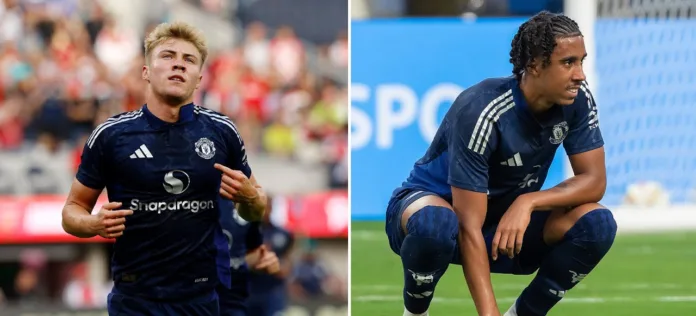Injuries to Rasmus Hojlund and Leny Yoro disrupt Manchester United’s pre-season plans, prompting lineup changes.
Manchester United is facing a challenging start to their season after key players Rasmus Hojlund and Leny Yoro suffered injuries during a pre-season match against Arsenal. Manager Erik ten Hag, now tasked with reconfiguring his squad, witnessed Hojlund, who scored early in the game, exit with a suspected hamstring injury. Shortly thereafter, Yoro, a summer signing, left the pitch with a muscle injury.
Jonny Evans, a veteran defender, confirmed the nature of Hojlund’s injury, while concerns over Yoro’s condition suggest he might be sidelined for an extended period. This situation forces Ten Hag to rethink his strategies and starting lineup for the upcoming fixtures, including a friendly against Real Betis and the Premier League’s opening matches.
The injuries came at a crucial time, with the season’s start just around the corner. Hojlund’s absence leaves a gap in United’s attacking lineup, while Yoro’s injury disrupts the defensive setup. In response, Ten Hag is likely to field Joshua Zirkzee, a new summer signing, as the central forward in place of Hojlund.
The expected starting lineup without Hojlund and Yoro includes Andre Onana in goal, with Diogo Dalot, Lisandro Martinez, Victor Lindelof, and Luke Shaw forming the defensive line. In midfield, the promising Kobbie Mainoo may partner with Scott McTominay and Bruno Fernandes. On the wings, Alejandro Garnacho and Marcus Rashford are set to continue their roles, providing width and pace.
This unexpected setback tests Manchester United’s squad depth and readiness for the new season. The situation underscores the importance of having a versatile and well-prepared squad to navigate injuries and maintain competitive performance.
Analysis:
Political:
The injury crisis at Manchester United could have broader implications for the team’s dynamics and management. Erik ten Hag’s handling of this situation will be closely monitored, as it reflects his strategic decision-making and adaptability under pressure. This scenario also highlights the importance of robust player fitness and rotation strategies, which can be critical in maintaining a team’s competitive edge in a demanding league like the Premier League.
Social:
Injuries to key players often spark discussions about player welfare, workload management, and the pressures faced by athletes in professional sports. Fans and analysts may debate the adequacy of United’s medical and fitness protocols, questioning whether the club has done enough to prevent such injuries. This situation also brings attention to the psychological and social support systems in place for injured players, as they navigate the challenges of recovery and reintegration into the team.
Racial:
While this particular event doesn’t directly address racial aspects, the diverse composition of Manchester United’s squad is a testament to the club’s inclusive approach. However, discussions about team dynamics, player roles, and the impact of injuries can sometimes intersect with broader conversations about diversity and representation in sports, highlighting the need for equitable treatment and opportunities for all players, regardless of their background.
Gender:
Though this news pertains to men’s football, it resonates with similar challenges faced in women’s sports, where injuries can significantly impact team performance and player careers. The conversation about injury management and support systems is equally relevant in both men’s and women’s sports, emphasizing the need for comprehensive healthcare and welfare strategies that address the unique needs of athletes across genders.
Economic:
Economically, injuries to high-profile players can have significant ramifications for a football club. They can affect ticket sales, merchandising, and sponsorships, as fans and sponsors are often drawn to the star players. The financial health of the club can be impacted by the performance of the team, which in turn is influenced by the availability of key players. Furthermore, the cost of signing replacements or investing in youth talent to fill gaps left by injured players can strain a club’s budget.
For Manchester United, a club with global recognition and substantial commercial interests, maintaining a competitive squad is crucial not only for success on the pitch but also for sustaining its financial and commercial momentum. The club’s response to this injury crisis, including potential mid-season transfers or increased reliance on youth academy players, will be scrutinized from an economic standpoint, as it could influence future financial decisions and strategies.
